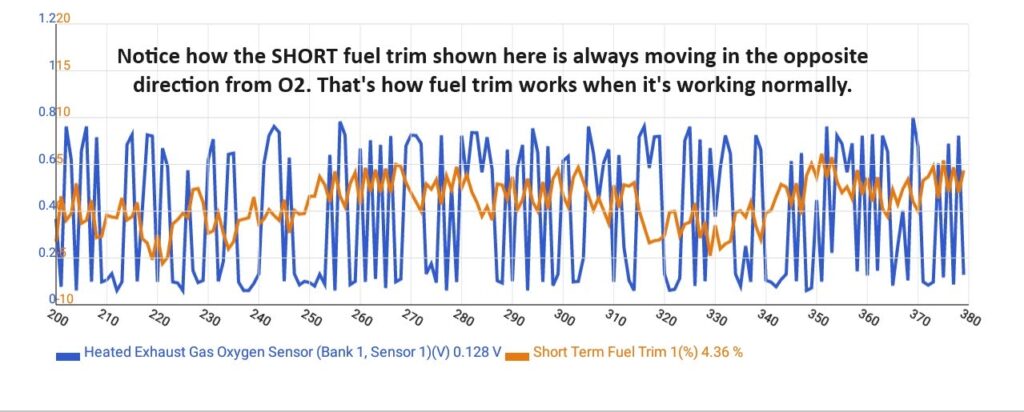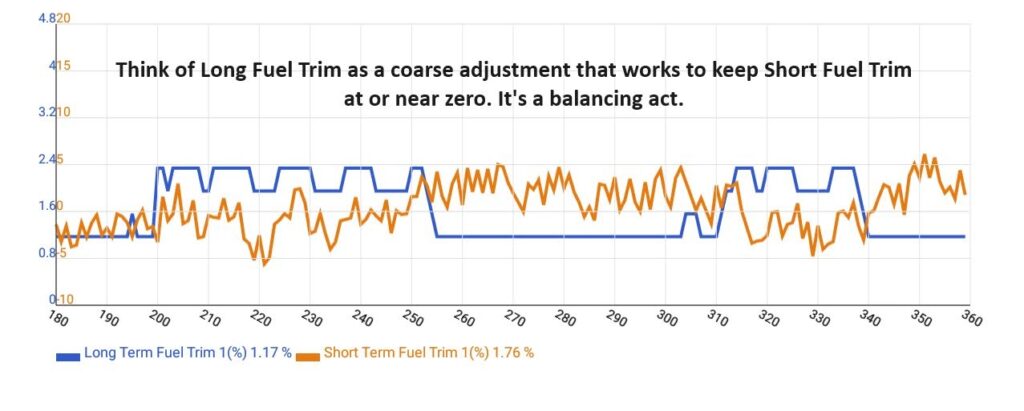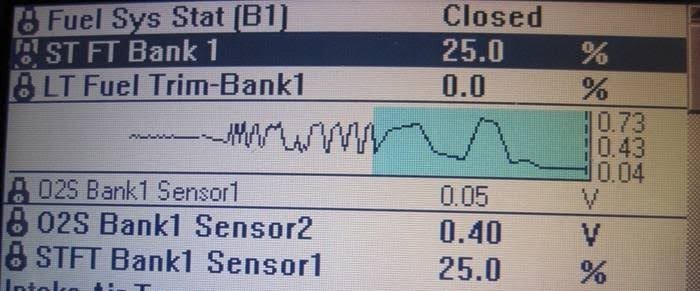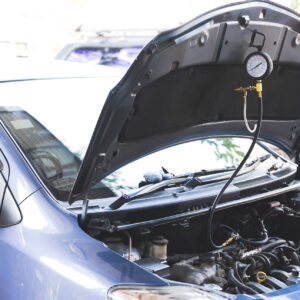The keyword where fuel trim is concerned is stoichiometry, which is a branch of chemistry dealing with relationships (in this case) between atomized fuel and atmosphere in the combustion chambers.
That’s the optimum balance of fuel and air by weight for the absolute cleanest burn.
Atmosphere at sea level is 14.7 pounds per square inch. It just so happens that the cleanest burn at sea level for the air fuel mix by weight is 14.7 parts of air to one part of fuel. These numbers change with altitude, but sea level is the baseline.
By volume, it’s 9,000 gallons of air to one gallon of fuel, but engineers do air fuel measurements by weight rather than volume, even when measuring fuel flow through injectors.
Before the catalytic converter even sees the exhaust coming out of the engine, the upstream O2 sensors are measuring the amount of oxygen in the exhaust stream and sending an analog signal back to the ECM/PCM so it can make constant, very minute fuel adjustments to keep the exhaust as clean as possible coming right out of the combustion chambers.
Engines with more than one bank will have fuel trim readings for both banks.
What Is Fuel Trim?
The fuel trim refers to the adjustment that the powertrain control module (PCM) makes to ensure the air and fuel mixture stays as close to its ideal ratio as possible.
Short-Term Fuel Trim
Short-term fuel trims refer to the immediate adjustments made by the PCM to the fuel delivery system based on immediate input from the upstream O2 sensor(s). A healthy O2 sensor signal is an analog waveform that switches from low voltage (more oxygen in the exhaust) to high voltage (less oxygen in the exhaust).

When the O2 sensor indicates lean, the short fuel trim algorithm tells the ECM/PCM to add a bit of fuel (positive fuel trim) and when the sensor indicates rich, it’s vice versa (negative fuel trim). This dance is continuous when the engine is in closed loop (using the O2 sensor signal).
Long-Term Fuel Trim (Adaptive Memory)

Long fuel trim responds when short fuel trim drifts too far from zero. Again, it’s responding to the same information that short fuel trim is but is a coarser adjustment designed to make larger corrections with the objective of keeping the mixture right even when something is wrong. Long fuel trim is an element of adaptive learning.

Of course, there’s only so much fuel trim can do. If the problem is bad enough, long term fuel trim will be maxed out trying to correct with adaptive learning, and you’ll get a DTC to the effect that adaptive limits have been reached.
To see if you fixed whatever was causing a fuel trim issue with your repair, remove the battery cables or use a scan tool to reset fuel trim and then restart and wait for closed loop to see what the short fuel trim does.

Why Is It Important to Balance the Air/Fuel Ratio?
It’s all about emissions. Protecting the catalytic converter with a good clean burn provides the cleanest emissions and the best fuel economy. But the fuel trim algorithms can keep the emissions clean even if there are problems unless the problems exceed the fuel trim’s ability to adapt. Usually by that time, you’ll feel it in the way the engine runs or you may see soot on the inside of your tailpipe.
Running Lean
If an engine runs lean, then there’s too much air and not enough fuel. Again, the fuel trim algorithms can, if the issue isn’t too severe, apply adaptive learning to prevent the engine from being damaged. If the engine is running extremely lean, the combustion events will be hotter and more NOx will be created.
Running Rich
Engines that run rich have too much fuel and not enough air. If the rich issue is too severe for the fuel trim algorithms to handle it, you’ll typically notice this in the fuel economy, soot in the exhaust pipe and on the tips of the plugs, misfires at idle due to sooty plugs, or, in some cases, hard starts or no-starts. The catalytic converter can also overheat due to hydrocarbons (HC) and carbon monoxide from too-rich mixtures. At the very least, the converter will have to work harder to deal with the exhaust.
What Do Positive and Negative Percentages in the Scanning Tool Mean?
A positive reading such means the ECM/PCM is correcting for a perceived lean condition (vacuum leak, unmetered airflow between the MAF and the throttle body, etc.) – too much air.
A negative fuel trim reading is correcting for a perceived rich condition (fuel contaminated engine oil, dripping injector, canister purse issue, high fuel pressure, etc.)
If you’ve repaired the cause for the fuel trim issue, the short term fuel trim will remain near zero.

What Factors Affect the Fuel Trim?
If your vehicle’s air/fuel ratio is out of balance, it’s best to determine the potential causes. Finding the factor responsible for an engine that runs rich or lean is essential if you want to address the problem. Common causes include the following issues:
- Bad oxygen sensors
- Failing mass airflow sensors
- Insufficient fuel
- Malfunctioning fuel system
- Stuck fuel injectors
- Too much time between oil changes
- Vacuum leaks
- Unmetered air leaks
- Packing the fuel tank and saturating the canister with fuel
- High fuel pressure due to a failed in-tank fuel pressure regulator
- Skewed ECT or IAT readings
Frequently Asked Questions About Fuel Trims
Here are the answers to some of the most commonly asked questions concerning short-term and long-term fuel trims.
What should the long-term fuel trim be at idle?
The long-term fuel trim normal range at idle should be at or near zero.
How do you monitor fuel trim?
The simplest way to monitor trim is to use an OBD II generic scanning tool. It’ll let you check both the short-term and long-term fuel trims at idle and at various loads.
If a concern is present, you’ll usually see it in the long term fuel trim rather than the short term fuel trim because the long term fuel trim dials in more fuel to drive short term fuel trim back to zero.
What should the long-term and short-term fuel trim be?
The long-term and short-term fuel trim readings should be between 5-10% whether the vehicle is idle or not.
Where to Get Scan Tools for Your Vehicle
One of the most useful tools you could have as a car owner is a scan tool. It lets you diagnose and reprogram vehicle control modules, allowing you to read and clear common error codes in the engine. If you’re looking for one, you won’t run out of options when you shop at CarParts.com.
We sourced our scan tools from only the most trusted brands in the industry to ensure they passed stringent testing procedures, guaranteeing maximum durability and dependability.
Order now, and check out securely in a matter of minutes. Thanks to our strategically located warehouses across the US, you can get your new scan tool delivered straight to your doorstep in as fast as two business days.
Also, you never worry about going over budget when you shop from us. All our products come with a low-price and lifetime replacement guarantee, helping you get the best value for your money.
Don’t miss out on the best deals on the market, and shop for a new scan tool for your vehicle today!
Any information provided on this Website is for informational purposes only and is not intended to replace consultation with a professional mechanic. The accuracy and timeliness of the information may change from the time of publication.






























My long term is at 16 percent. Short term is 0. I have an open loop due to insufficient engine temp
My car doesn’t go up hill as it really should. And had a lil back fire but changing. A cylinder helped that out. I haven’t taken it on the high way but will today